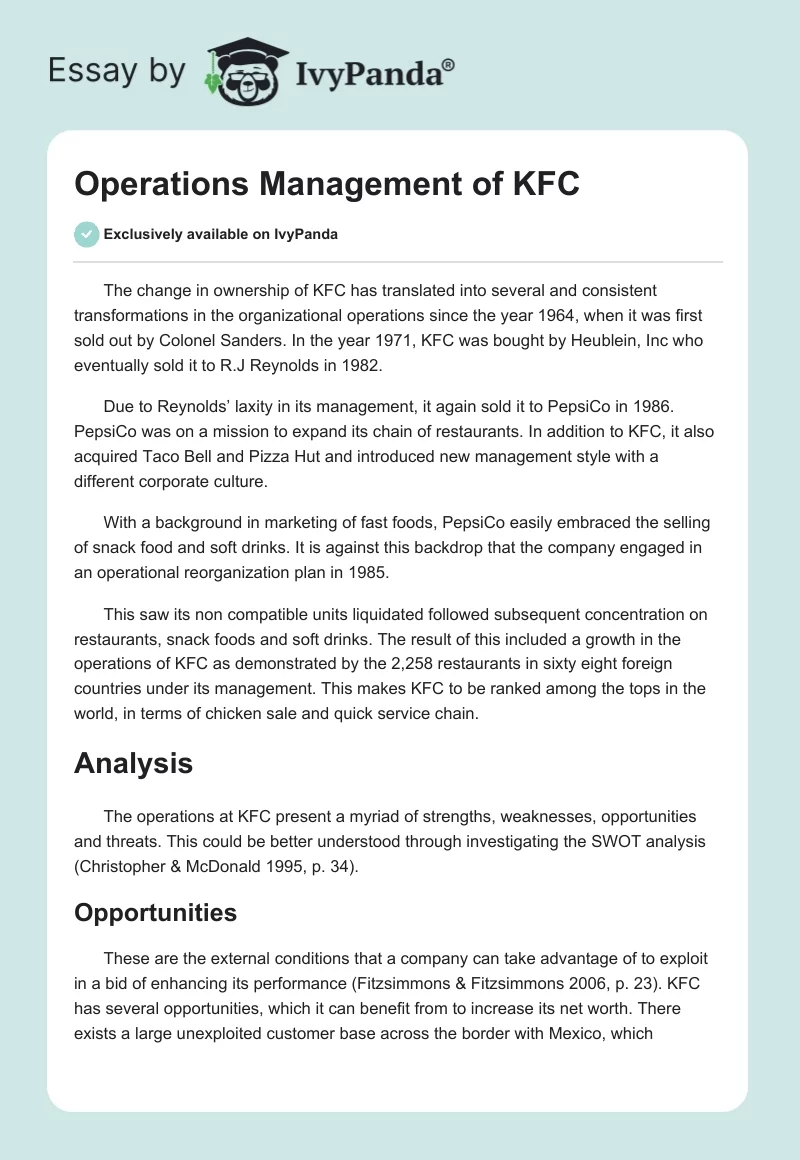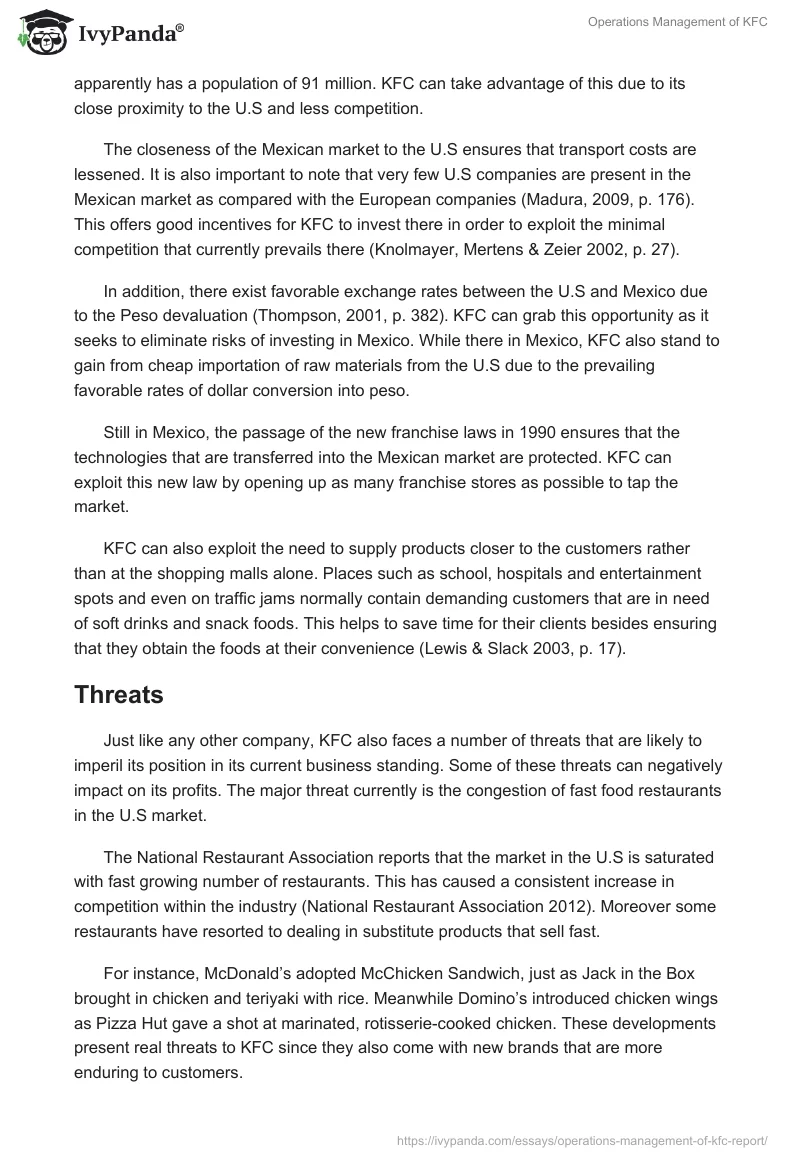The change in ownership of KFC has translated into several and consistent transformations in the organizational operations since the year 1964, when it was first sold out by Colonel Sanders. In the year 1971, KFC was bought by Heublein, Inc who eventually sold it to R.J Reynolds in 1982.
Due to Reynolds’ laxity in its management, it again sold it to PepsiCo in 1986. PepsiCo was on a mission to expand its chain of restaurants. In addition to KFC, it also acquired Taco Bell and Pizza Hut and introduced new management style with a different corporate culture.
With a background in marketing of fast foods, PepsiCo easily embraced the selling of snack food and soft drinks. It is against this backdrop that the company engaged in an operational reorganization plan in 1985.
This saw its non compatible units liquidated followed subsequent concentration on restaurants, snack foods and soft drinks. The result of this included a growth in the operations of KFC as demonstrated by the 2,258 restaurants in sixty eight foreign countries under its management. This makes KFC to be ranked among the tops in the world, in terms of chicken sale and quick service chain.
Analysis
The operations at KFC present a myriad of strengths, weaknesses, opportunities and threats. This could be better understood through investigating the SWOT analysis (Christopher & McDonald 1995, p. 34).
Opportunities
These are the external conditions that a company can take advantage of to exploit in a bid of enhancing its performance (Fitzsimmons & Fitzsimmons 2006, p. 23). KFC has several opportunities, which it can benefit from to increase its net worth. There exists a large unexploited customer base across the border with Mexico, which apparently has a population of 91 million. KFC can take advantage of this due to its close proximity to the U.S and less competition.
The closeness of the Mexican market to the U.S ensures that transport costs are lessened. It is also important to note that very few U.S companies are present in the Mexican market as compared with the European companies (Madura, 2009, p. 176). This offers good incentives for KFC to invest there in order to exploit the minimal competition that currently prevails there (Knolmayer, Mertens & Zeier 2002, p. 27).
In addition, there exist favorable exchange rates between the U.S and Mexico due to the Peso devaluation (Thompson, 2001, p. 382). KFC can grab this opportunity as it seeks to eliminate risks of investing in Mexico. While there in Mexico, KFC also stand to gain from cheap importation of raw materials from the U.S due to the prevailing favorable rates of dollar conversion into peso.
Still in Mexico, the passage of the new franchise laws in 1990 ensures that the technologies that are transferred into the Mexican market are protected. KFC can exploit this new law by opening up as many franchise stores as possible to tap the market.
KFC can also exploit the need to supply products closer to the customers rather than at the shopping malls alone. Places such as school, hospitals and entertainment spots and even on traffic jams normally contain demanding customers that are in need of soft drinks and snack foods. This helps to save time for their clients besides ensuring that they obtain the foods at their convenience (Lewis & Slack 2003, p. 17).
Threats
Just like any other company, KFC also faces a number of threats that are likely to imperil its position in its current business standing. Some of these threats can negatively impact on its profits. The major threat currently is the congestion of fast food restaurants in the U.S market.
The National Restaurant Association reports that the market in the U.S is saturated with fast growing number of restaurants. This has caused a consistent increase in competition within the industry (National Restaurant Association 2012). Moreover some restaurants have resorted to dealing in substitute products that sell fast.
For instance, McDonald’s adopted McChicken Sandwich, just as Jack in the Box brought in chicken and teriyaki with rice. Meanwhile Domino’s introduced chicken wings as Pizza Hut gave a shot at marinated, rotisserie-cooked chicken. These developments present real threats to KFC since they also come with new brands that are more enduring to customers.
The recent past few decades has seen a dramatic change in the preference of consumers. This has promoted companies to keep on changing their brand images to suit the customers’ preferences. In this quest, important aspects of the products could be lost. In its bid to satisfy the ever changing customer preferences, KFC has undergone several changes that are tailor made to correspond with the client’s needs (Bidgoli 2010, p. 56).
As it undergoes its endeavor to exploit the Mexican market, KFC has had to confront a number of challenges including dealing with very complacent labor force. Although labor costs are relatively cheap in Mexico, most labors are lazy, unreliable and absent themselves from duty frequently. Mexico also experiences frequent security threats posed by drug gangs. This has made the operations of KFC in that country insecure due to constant fears of attacks by the drug lords and gangs (Davis et al. 2008, p. 181).
Strengths
These are the internal conditions that are available within the company that makes a company stands a better ground of pursuing its goals effectively. For the KFC, they pride themselves as being the first chain to ever give a shot at a fast food industry. This provided them with a niche above the rest besides giving them a shot in the arm especially when it comes to advertisements.
Moreover, being the earliest entrant into the industry has allowed them to build on a brand name and firmly anchor their roots within the business. This has served to enhance their reputation and recognition. The acquisition of KFC by PepsiCo was another shot in the arm. This is because PepsiCo was already experienced in operational management and therefore KFC received the much needed operational organization under PepsiCo (Needle 2010, p. 63).
The company also boasts of excellent loyalty from its employees. This is a tradition that was created by the company’s founder, Colonel Sander. This devotion of employees has in extent led to the provision of quality services to customers, which include clean and hygiene restaurants, improved customer relations and high quality services, which are served in fast and friendlier manner (Knolmayer et al. 2002, p. 42).
Weaknesses
These are the conditions that are found within the internal structure of a company and have potentials of derailing a company’s progress. KFC has apparently undergone change in ownership as many times as possible. This has in essence led to confusion in the corporate direction of the company.
The company has also been characterized by delays when it comes to adoption and subsequent marketing of new products. For instance, at the time when McDonald’s was developing McChicken, KFC still retained its age old KFC sandwich. Incidentally customers are more likely to be endured to innovative companies than non innovative ones (Hensher 2001, p. 38).
The founder and manager of KFC preferred a laid back approach of management, which served to earn his employees’ devotion to the company. However, when the company was bought by PepsiCo, a more aggressive form of operational management was adopted. These two conflicting cultures of management resulted in confusion of employees. In addition, the sale resulted in a change in the top management of the company. This change altered the operational organization of the company (Hillier & Hillier 2010, p. 71).
Evaluation and Summary
The SWOT analysis has been used to evaluate the effectiveness of the operations management of the KFC. They provide adequate tools and equipments for analyzing the modalities of managing the operations of the company in addition to offering information on areas of key interest.
From the SWOT analysis, it is evident that the company has undergone a number of transformations in terms of ownership and management. Some of these changes have been accompanied by equal measure of challenges that the company has been able to exploit for its own benefit. Others however have brought with them outstanding threats that calls for fresh thoughts and approaches in decision making (Lewis & Slack 2003, p. 69).
One important oversees investment destination for KFC is the Mexico. This is attributed to the fact that it has minimal competition, high customer base, favorable exchange rates due to the devaluation of the of the peso and low labor costs. However, these are not conditions which are permanent. A change in any or all of these conditions might result in subsequent disruptions in the operations of the KFC. It is against this backdrop that KFC should explore other market destinations and seek other strategic alternatives.
References
Bidgoli, H 2010, The handbook of technology management: supply chain management, marketing and advertising, and global management, John Wiley and Sons, NewYork.
Christopher, M & McDonald, M 1995, Marketing: an introductory text, Macmillan Business, Salt Lake.
Davis, B, Lockwood, A, Alcott, P & Panterlidis, L 2008, Food and beverage management, Elsevier, Salt Lake.
Fitzsimmons, J & Fitzsimmons, MJ 2006, Service management: operations, strategy, and information technology, McGraw-Hill/Irwin, New York.
Hensher, DA 2001, Handbook of logistics and supply-chain management, Emerald Group Publishing, Emerald.
Hillier, F & Hillier, MS 2010, Introduction to management science: a modeling and case studies approach with spreads, McGraw-Hill Higher Education, New York.
Knolmayer, G, Mertens, P & Zeier, A 2002, Supply chain management based on SAP systems: order management in manufacturing companies, Springer, New Mexico.
Lewis, M & Slack, N 2003, Operations management: critical perspectives on business and management, Routledge, Hull City.
Madura, J 2009, International financial management, World Scientific Public Co. Plc, Farrer Road.
National Restaurant Association 2012, NRA products & services, <https://chooserestaurants.org/>.
Needle, D 2010, Business in context: an introduction to business and its environment, Cengage Learning EMEA, Waterford.
Thompson, H 2001, International economics: global markets and international competition, Cengage Learning, Mason, OH.


